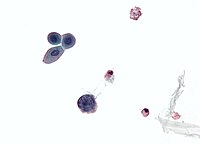
Photo from wikipedia
Introduction DNA repair by the nonhomologous end joining (NHEJ) pathway promotes tumor recurrence after chemotherapy and radiotherapy. Discovery of rapid and high-throughput techniques to screen for an effective NHEJ inhibitor… Click to show full abstract
Introduction DNA repair by the nonhomologous end joining (NHEJ) pathway promotes tumor recurrence after chemotherapy and radiotherapy. Discovery of rapid and high-throughput techniques to screen for an effective NHEJ inhibitor drug is imperative for the suppression of NHEJ during tumor treatment. However, traditional screening methods are too cumbersome to meet the current need. Zebrafish is an ideal model for drug screening due to the specificity of its early embryonic development and similarity of tumor cell generation. By exploiting the high frequency of NHEJ in early embryonic development, we established a model that uses a transcriptional terminator signal fragment from the Simian virus 40 (SV40) to cause embryonic lethality. SV40 fragment-induced embryonic lethality was alleviated by 5,6-bis ((E)-benzylideneamino)-2-mercaptopyrimidin-4-ol or C18H14N4OS (SCR7), an NHEJ inhibitor. Materials and methods A 122 bp SV40 terminator fragment (10 ng/µL) was microinjected into zebrafish zygotes. SV40 fragment integration into the zebrafish embryonic genome was detected by Southern blot using a DNA probe for the SV40 terminator. Embryonic lethality rates were observed 24 and 48 h after microinjection. A nonhomologous recombinant inhibitor, SCR7 (5 µM), was used to alleviate embryonic lethality. Results Microinjection of zebrafish embryos with the SV40 terminator fragment (10 ng/µL) caused a progressive increase in mortality over time. Using Southern blots, we confirmed that SV40 terminator sequences were integrated into the zebrafish embryonic genome. This phenomenon was effectively alleviated by addition of SCR7. Conclusion Injection of an SV40 terminator into zebrafish embryos may cause embryonic lethality due to NHEJ during early zebrafish development. The high mortality of zebrafish embryos could be alleviated by using the NHEJ inhibitor, SCR7. The zebrafish model presented here is simpler and more convenient than traditional methods of screening for NHEJ inhibitors and can be utilized in large-scale drug screens for NHEJ inhibitors and for the development of novel anticancer drugs.
Journal Title: OncoTargets and therapy
Year Published: 2018
Link to full text (if available)
Share on Social Media: Sign Up to like & get
recommendations!